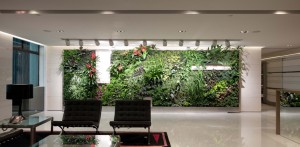Office Plants that are good for your health
Multiple studies worldwide find greenery purifies air and improves attitude and performance.

Conjure up a standard office cubicle: There is the gray desktop with filing drawers, the ubiquitous computer monitor, a keyboard and mouse, a few (or a lot of) papers. Now place a peace lily, with its dark green leaves and elegant white flower, into the mental image. With that addition, most of us would say the office cubicle has just become a much nicer place to work.
It’s not just common sense that says the addition of plants makes an office space more inviting. Decades of scientific research detail the benefits plants add to the workplace: improved concentration, performance, job satisfaction, health and mood.
Just last year, for example, a Norwegian study added further support to the idea that plants in the workplace can help improve workers’ attention. Research participants were given an attention-demanding task to complete, then given a short break, then another task. Half of the participants completed the set of tasks in a room with flowers and plants; the others were in a room without plants. The attention capacity of the workers in the room with flowers and plants showed greater improvement on the second task than those sitting at a bare desk.
In addition, a 2008 University of Michigan study found that memory performance and attention spans improved by 20 percent after people spent an hour interacting with nature — either by going outside or just by viewing pictures of nature, as opposed to walking urban routes or viewing urban photographs.
Other studies suggest the presence of plants also seems to improve attitude. Workers primarily in Texas and the Midwest were surveyed for a 2008 study on “the effect of live plants and window views of green spaces on employee perceptions of job satisfaction.” Texas researchers found that individuals — without regard to age, ethnicity, salary, education levels or position — “who worked in offices with plants and windows reported that they felt better about their job and the work they performed.”
The particular plant that will make an office a happier place is somewhat subjective. “Orchids are among my favorites for atmosphere and mood,” says Cody Hoya, general manager at North Haven Gardens. “They’re beautiful, unique, colorful and very long-lasting.”
Both Hoya and Josh Addison, manager of Redenta’s Garden Dallas location, agree that tillandsias, also known as air plants, are natural choices for adding a touch of whimsy to the office. There are a number of varieties available due to their current popularity, and they are not expensive, unless you choose a large specimen. They require little care, and they should survive under typical office fluorescent light, says Addison. “But if you have windows, put them close by.”
If you think you might tire of looking at the same plant on your desk day after day, try Hoya’s mix-and-match technique. “I like to use an interesting basket or ceramic vessel in which I can group several different interior plants, both blooming and foliage, in their nursery pots dressed with a bit of moss,” he says. “This allows for flexibility to rotate the plants and change the composition every couple of months so that the plants get a change of location and the interest stays fresh.”
Studies of various benefits of indoor plants were perhaps inspired by the NASA Clean Air Study in the 1980s that suggested certain common indoor plants might provide a natural way of removing toxins such as benzene, formaldehyde and trichloroethylene from the air. Hundreds of toxic chemicals can be outgassed by furniture, carpets and building material and then trapped in the closed ventilation systems of tightly sealed, energy-efficient buildings. The chemicals can lead to headaches, fatigue and allergic reactions now called Sick Building Syndrome.
Purifying the air is an often-touted benefit of indoor plants, but the plants in these clean-air studies typically have been grown in sub-irrigated soil media or clay pebble hydroculture. The author of NASA’s Clean Air Study, B.C. Wolverton, also found that the more air that moved across the plant’s roots, the more toxins could be removed from the air.
This research led Wolverton to develop the Plant Air Purifier, an air-filtration system that includes a planter with a built-in electric fan, ceramic growing medium and activated carbon. The idea is that when the planter is plugged in, it sucks dirty air down into the root area, where activated carbon captures pollutants and holds on to them until the root system can use them as a food source. At the end of the natural process, the plant releases fresh air into the room.
If living indoor plants help mood and possibly contribute to cleaner air, common sense might dictate that dying indoor plants might do just the opposite. The first tip to good plant health is to “place plants suited to various light levels accordingly, and keep them from constant drafts from heating and cooling vents,” says Hoya.
Signs of insufficient light can include yellowing or dropping leaves, says Addison. “Succulents may get leggy, reaching for light.” If you have an office with a window, it may help to rotate your office plant periodically so that it gets a more even exposure to the stronger light.
Don’t overwater indoor plants. “Water behaves differently in soil in a pot inside than it does outside,” Hoya says. “Always water deeply, until water drains freely from the bottom of the pot, but less frequently. For most plants, averaging a soil that feels mildly damp but not soggy is ideal.”
When to water will vary with an office’s environmental conditions. If the potting medium is damp, do not water until it is dry. Just know the recommended care for whatever plant you choose. Tillandsias, for instance, should be dunked in water once a week, says Addison, or spritzed with water about every third or fourth day.
Wipe plant leaves occasionally to get rid of dust, as well.
Finally, the actual action of gardening has its benefits. A 2011 study found that gardening restored a positive mood after a stressful task. Bonsai and small terrariums are gardening activities that could take place indoors in an office.
“People become pretty relaxed when they work with houseplants, because you forget your troubles. Your mind tends to focus upon the plant, and you become meditative. And that meditative state is, of course, very calming and stress-reducing,” says Richard Sunshine, owner of Sunshine Miniature Trees in Dallas.
Ming aralias and Fukien tea trees are among the plants that have the twisted, aged look and other characteristics that people often desire in a bonsai. Both do well in typical office fluorescent lighting. In fact, Sunshine tells how he learned how well the Ming aralias can survive in an office setting. Years ago, his company was caring for plants at Zale Corp.’s national headquarters. Then-Zale chairman Ben Lipshy, a bonsai collector, often came to the store to pick out new bonsai trees.
“He kept coming into the store buying Ming aralias. And we found out that he was taking the bonsai aralias and placing them all over the office where they were getting absolutely no natural light. It was an example of the student teaching the teacher. That’s how we learned that the Ming aralia was one of the very best plants for interior offices.”
Rebecca Perry is a Milford freelance writer.
Suitable plants
Which plants are likely to thrive in an office and help you thrive, as well? It depends to some degree on the light conditions. Most of the plants listed below have multiple species, which provide options in leaf and flower color and mature size.
| LOW LIGHT | INTERMEDIATE LIGHT | BRIGHT INDIRECT LIGHT |
| Aglaonema | Aralia | Bromeliads |
| Aspidistra ‘Cast Iron’ Plant | Pothos & Hedera Ivy | Orchids |
| Dracaena | Philodendron | Codiaeum ‘Croton’ |
| Spathiphyllum | Neophrolepsis Ferns | Strelitzia ‘Bird of Paradise’ |
| Sansevieria | Zamioculcas Zamiifolia ‘ZZ’ | Succulents |
| Schefflera | ||
| For additional plant selections visit our Interior Plant Catalog | ||



